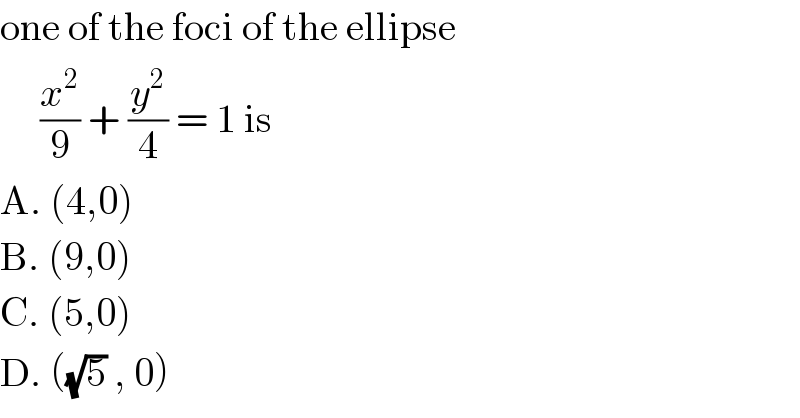Question Number 76819 by Rio Michael last updated on 30/Dec/19

$$\mathrm{one}\:\mathrm{of}\:\mathrm{the}\:\mathrm{foci}\:\mathrm{of}\:\mathrm{the}\:\mathrm{ellipse} \\ $$$$\:\:\:\:\:\frac{{x}^{\mathrm{2}} }{\mathrm{9}}\:+\:\frac{{y}^{\mathrm{2}} }{\mathrm{4}}\:=\:\mathrm{1}\:\mathrm{is} \\ $$$$\mathrm{A}.\:\left(\mathrm{4},\mathrm{0}\right) \\ $$$$\mathrm{B}.\:\left(\mathrm{9},\mathrm{0}\right) \\ $$$$\mathrm{C}.\:\left(\mathrm{5},\mathrm{0}\right) \\ $$$$\mathrm{D}.\:\left(\sqrt{\mathrm{5}}\:,\:\mathrm{0}\right) \\ $$
Commented by zainal tanjung last updated on 21/Apr/20

$$\mathrm{e}=\sqrt{\mathrm{3}^{\mathrm{2}} −\mathrm{2}^{\mathrm{2}} }\:=\sqrt{\mathrm{5}} \\ $$$$\mathrm{solusion}:\:\mathrm{D}\:\left(\sqrt{\mathrm{5}}\:\:,\:\mathrm{0}\right) \\ $$
Commented by MJS last updated on 31/Dec/19

$${e}^{\mathrm{2}} ={a}^{\mathrm{2}} −{b}^{\mathrm{2}} \\ $$$${a}=\mathrm{3};\:{b}=\mathrm{2} \\ $$$$\Rightarrow\:{e}=\sqrt{\mathrm{5}} \\ $$
Commented by JDamian last updated on 30/Dec/19

$$\frac{{x}^{\mathrm{2}} }{\mathrm{3}^{\mathrm{2}} }+\frac{{y}^{\mathrm{2}} }{\mathrm{2}^{\mathrm{2}} }=\mathrm{1} \\ $$$$ \\ $$$${All}\:{points}\:{on}\:{this}\:{ellipse}\:{satisfy} \\ $$$$−\mathrm{3}\leqslant{x}\leqslant+\mathrm{3} \\ $$$$−\mathrm{2}\leqslant{y}\leqslant+\mathrm{2} \\ $$$${D}\:{is}\:{only}\:{one}\:{possible}\:{solution} \\ $$
Commented by zainal tanjung last updated on 21/Apr/20

$$\:\frac{{x}^{\mathrm{2}} }{\mathrm{3}^{\mathrm{2}} }\:+\:\frac{{y}^{\mathrm{2}} }{\mathrm{2}^{\mathrm{2}} }\:=\:\mathrm{1} \\ $$$$−\mathrm{3}\leqslant\mathrm{x}\leqslant\mathrm{3} \\ $$$$−\mathrm{2}\leqslant\mathrm{y}\leqslant\mathrm{2} \\ $$
